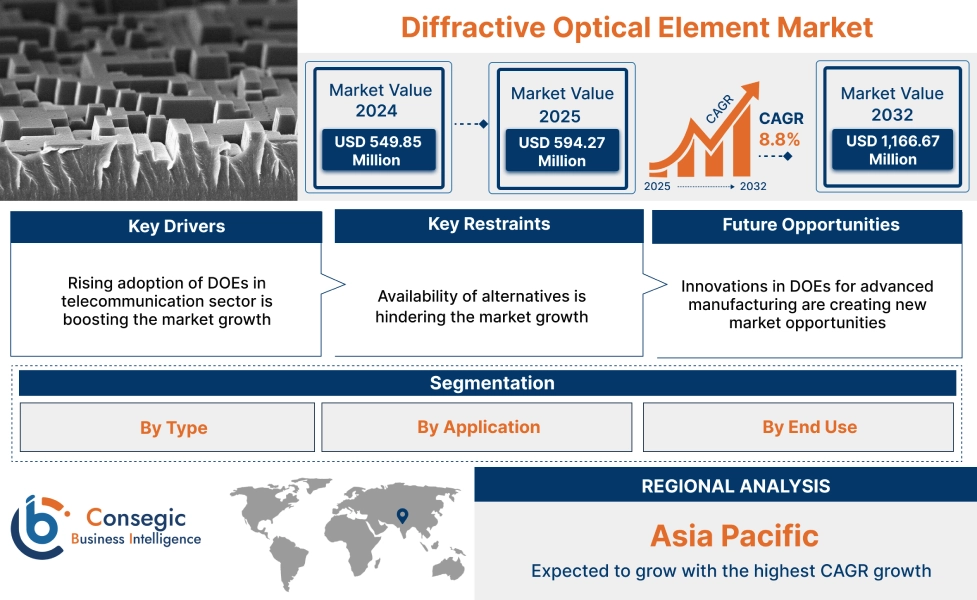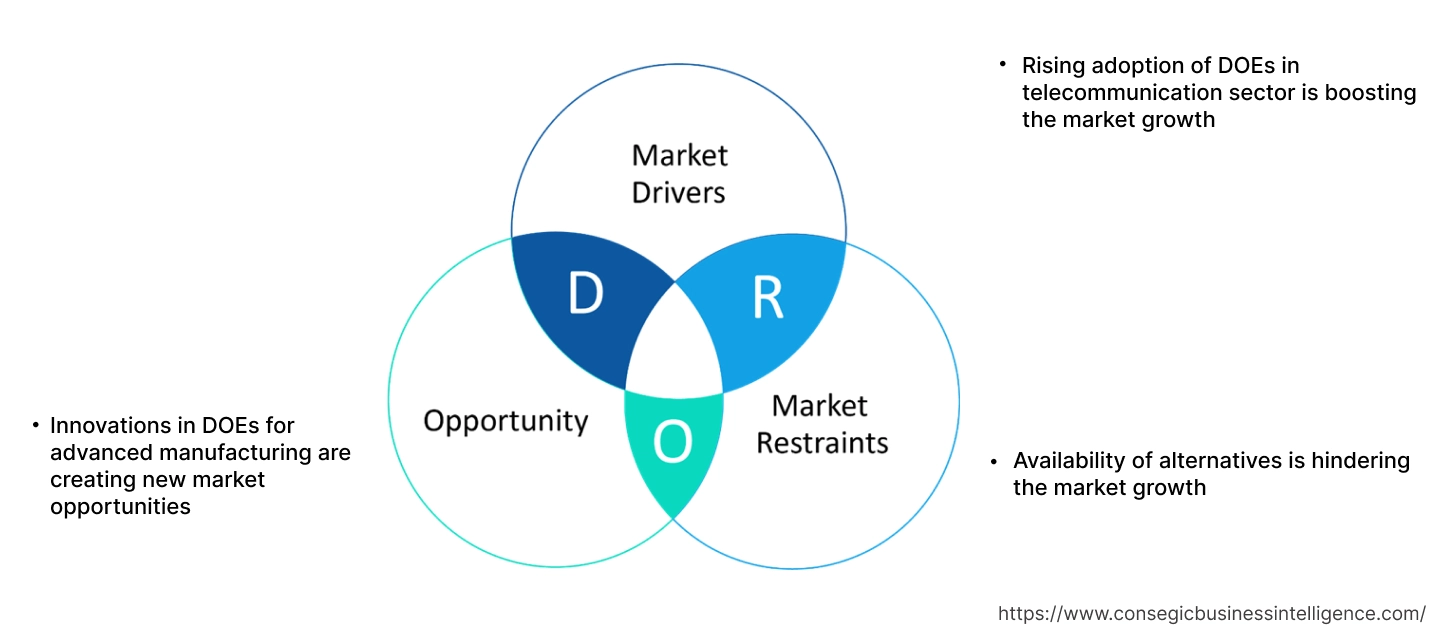Diffractive Optical Element Market Size:
Diffractive Optical Element Market size is estimated to reach over USD 1,166.67 Million by 2032 from a value of USD 549.85 Million in 2024 and is projected to grow by USD 594.27 Million in 2025, growing at a CAGR of 8.8% from 2025 to 2032.
Diffractive Optical Element Market Scope & Overview:
A diffractive optical element (DOE) is a component that manipulates light through diffraction, a phenomenon where light bends around obstacles or spreads out when passing through narrow openings. DOEs are designed with micro- or nano-structured surface patterns that cause this bending of light, allowing them to split, focus, or reshape light beams in specific ways. DOEs have intricate surface patterns, often with features on the scale of micrometers or nanometers, that are engineered to diffract light in a desired manner. DOEs are much thinner and lighter than traditional refractive optics, making them suitable for space-constrained applications.
How is AI Impacting the Diffractive Optical Element Market?
AI is revolutionizing the diffractive optical element (DOE) market by accelerating the design and fabrication of these complex optical components. Traditional design methods are slow and iterative, but AI algorithms, particularly machine learning and generative models, can analyze vast datasets to create intricate patterns and optimize designs for specific performance criteria with unprecedented speed. This dramatically reduces the time and cost associated with prototyping and testing. Furthermore, AI enhances the manufacturing process by fine-tuning fabrication parameters, leading to higher quality and more uniform products. This synergy between AI and DOEs is enabling new applications in augmented reality, LiDAR, and advanced imaging systems.
Diffractive Optical Element Market Dynamics - (DRO) :
Key Drivers:
Rising adoption of DOEs in telecommunication sector is boosting the market growth
Diffractive optical elements play a vital role in modern telecommunications, particularly in enhancing data transmission rates and network performance through optical communication systems. They are used in various applications, including wavelength division multiplexing (WDM), beam shaping, and beam splitting, all of which are crucial for high-speed internet and data transmission. By enabling efficient signal processing and data transmission, DOEs contribute to the high-speed capabilities of modern telecommunication networks, supporting the demands of the digital age. In some advanced systems, DOEs are used with vortex beams to enable spatial division multiplexing, enhancing data transmission rates using multiple input multiple output (MIMO) technology.
- For instance, according to PWC, global telecom industry revenue across fixed and mobile surged by 4.3% in 2023 reaching USD 1.14 trillion. This growing telecom sector is increasing the adoption of DOEs, in turn boosting the market.
Thus, the aforementioned factors are boosting the adoption of DOEs in turn driving the diffractive optical element market growth.
Key Restraints:
Availability of alternatives is hindering the market growth
Alternatives to diffractive optical elements include refractive doublets, liquid crystal spatial light modulators (LC-SLMs), deformable mirrors, and prefabricated dielectric masks. These alternatives offer different approaches to manipulating light. Liquid crystal spatial light modulators (LC-SLMs) and deformable mirrors are controllable optics that can dynamically adjust their optical properties. LC-SLMs modulate light based on polarization, while deformable mirrors change their shape to alter the wavefront. Prefabricated dielectric masks with feature sizes in the nanometer range, can be used to create diffractive structures. Moreover, refractive doublets, made from specific material pairs, are used to correct chromatic aberrations. They offer higher efficiency and reduced stray light compared to single-material DOEs.
Thus, the market trends analysis shows that the aforementioned factors are restraining the diffractive optical element market demand.
Future Opportunities :
Innovations in DOEs for advanced manufacturing are creating new market opportunities
Progressions in advanced manufacturing are crucial for realizing the full potential of DOEs. Moreover, DOEs are becoming increasingly important in various applications like laser material processing, imaging, and optical communications. The ability to fabricate DOEs with high precision and complex geometries is directly related to breakthroughs in manufacturing technologies like nanoimprinting, lithography, and 3D printing. Novel 3D printing methods offer the potential to fabricate complex 3D DOEs, expanding the range of achievable optical functionalities. Nanoimprinting and lithography enable the creation of intricate micro- and nanoscale patterns required for DOEs, enabling finer control over light manipulation.
Thus, the advancements in DOEs are projected to drive diffractive optical element market opportunities during the forecast period.
Diffractive Optical Element Market Segmental Analysis :
By Type:
Based on the type, the market is segmented into beam shapers, beam splitters, and beam diffusers.
Trends in the Type:
- Rising adoption of beam splitters due to their relatively small size and ability to easily integrate into optical systems is boosting the diffractive optical element market size.
- Increasing demand for beam diffusers due to their ability to achieve high levels of intensity uniformity, often within a few percent.
The beam diffusers segment accounted for the largest revenue share of 45.60% in the market in 2024.
- A diffractive beam diffuser, also known as a beam homogenizer, is an optical component that transforms a focused laser beam into a more uniform, broader beam profile.
- It utilizes DOEs to manipulate the wavefront of light, spreading the light energy over a wider area and reducing intensity variations.
- This process results in a more uniform illumination, which is crucial in various applications where a consistent light distribution is required.
- Diffractive diffusers are used to create uniform laser beams for applications like ablation, marking, scribing, and welding.
- Therefore, the aforementioned factors are boosting the diffractive optical element market growth.
The beam splitters segment is expected to register the fastest CAGR during the forecast period.
- Diffractive beam splitters are optical elements that use diffraction to split a single laser beam into multiple beams, forming a 1D or 2D array of spots.
- They are crucial in various applications, including laser micromachining, 3D sensing, and quantum technologies, offering advantages like high accuracy, compact size, and high laser damage threshold.
- Diffractive beam splitters enable simultaneous processing of multiple points on a workpiece, significantly increasing the speed of laser cutting, drilling, scribing, and ablation.
- Diffractive beam splitters are used in optics-based quantum computing systems to generate spot arrays for trapping atoms, multiplexing signals, and exciting quantum dots.
- Thus, the aforementioned factors are expected to boost the diffractive optical element market trends during the forecast period.
By Application:
Based on the application, the market is segmented into biomedical devices, laser material processing, LIDAR, communication optical sensors, lithographic and holographic lighting, and others.
Trends in the Application:
- Rising adoption of DOEs to create compact and efficient LIDAR systems for navigation and object detection in self-driving cars is boosting the diffractive optical element market size.
- Increasing trend in adoption of DOEs in holographic displays and projectors to create complex 3D images by diffracting laser light.
The communication optical sensors segment accounted for the largest revenue share in the diffractive optical element market share in 2024.
- DOEs are used in optical communication sensors to manipulate light through diffraction, enabling functionalities like beam shaping, beam splitting, and focusing.
- They are particularly useful in applications where precise control of light's phase, amplitude, and polarization is required.
- DOEs compensate for imperfections in optical systems, improving image quality and signal transmission in sensors and communication devices.
- Therefore, the market trend analysis shows that the aforementioned factors are boosting the diffractive optical element market demand.
The biomedical devices segment is expected to register the fastest CAGR during the forecast period.
- Diffractive optical elements (DOEs) are used in a variety of biomedical devices due to their ability to manipulate light in specific ways.
- These elements, which utilize diffraction rather than refraction, are employed in applications such as laser material processing, medical laser treatments, and diagnostic instruments.
- They shape laser beams, create structured illumination patterns for microscopy, and even be incorporated into optical sensors.
- DOEs are used in surgical tools to deliver light for precise cutting or coagulation.
- Thus, the market analysis shows that the aforementioned factors are expected to boost the diffractive optical element market trends during the forecast period.
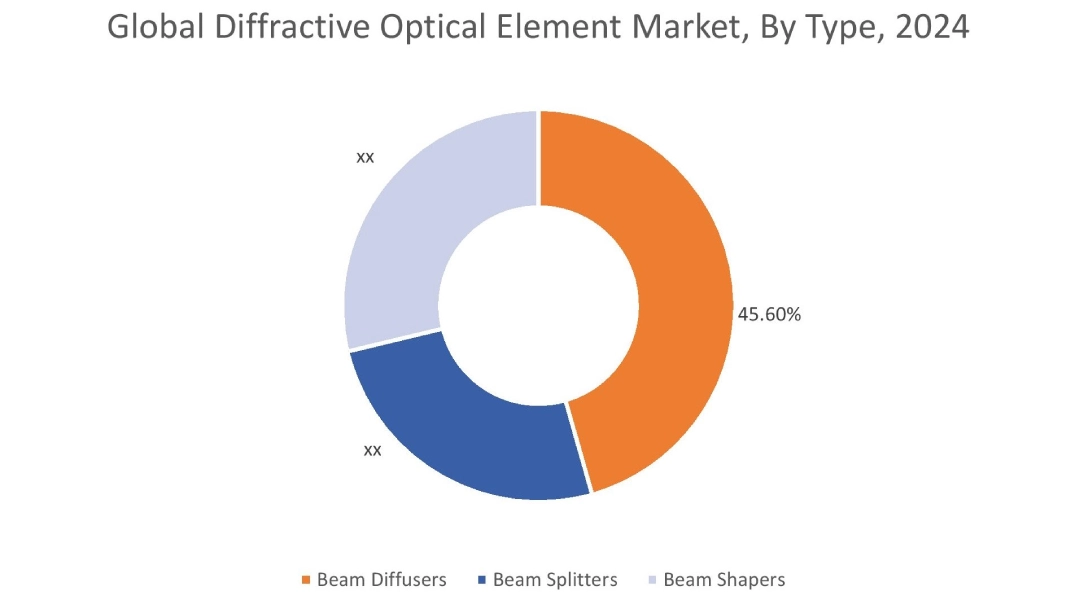
By End Use:
Based on the end use, the market is segmented into telecommunication, healthcare, electronics and semiconductor, and others.
Trends in the End Use:
- Increasing demand for DOEs for free-space optical communication systems for beam shaping, aiming, and tracking.
- Rising adoption of DOEs in telecommunication industry due to factors including precise control of light and higher data transmission rates, improved system performance, and innovative functionalities.
The electronics and semiconductor segment accounted for the largest revenue share in the diffractive optical element market share in 2024.
- Diffractive optical elements (DOEs) are used in semiconductor and electronics industries for various applications like laser material processing, beam shaping, and 3D sensing.
- They work by manipulating the wave nature of light using microstructures to achieve specific light patterns and beam shapes, offering advantages over traditional refractive optics in certain applications.
- DOEs are used for beam shaping in laser welding, cutting, drilling, and soldering in manufacturing. They split laser beams into multiple spots or modify the beam profile for precise material processing.
- Therefore, the aforementioned factors are boosting the diffractive optical element market expansion.
The healthcare segment is expected to register the fastest CAGR during the forecast period.
- Diffractive optical elements (DOEs) are used in healthcare for a variety of applications due to their ability to manipulate light with high precision.
- They are found in medical devices for imaging, diagnostics, and laser treatments, contributing to improved accuracy, speed, and resolution.
- Specifically, DOEs enhance optical coherence tomography (OCT) for retinal imaging, enabling detailed measurements of retinal layer thickness for conditions like glaucoma and diabetic retinopathy.
- DOEs are used in laser surgery, for example, in laser eye surgery, and in other laser-based procedures, to shape and focus laser beams with high precision.
- Thus, the market analysis depicts that the aforementioned factors are expected to boost the diffractive optical element market opportunities during the forecast period.
Regional Analysis:
The regions covered are North America, Europe, Asia Pacific, the Middle East and Africa, and Latin America.
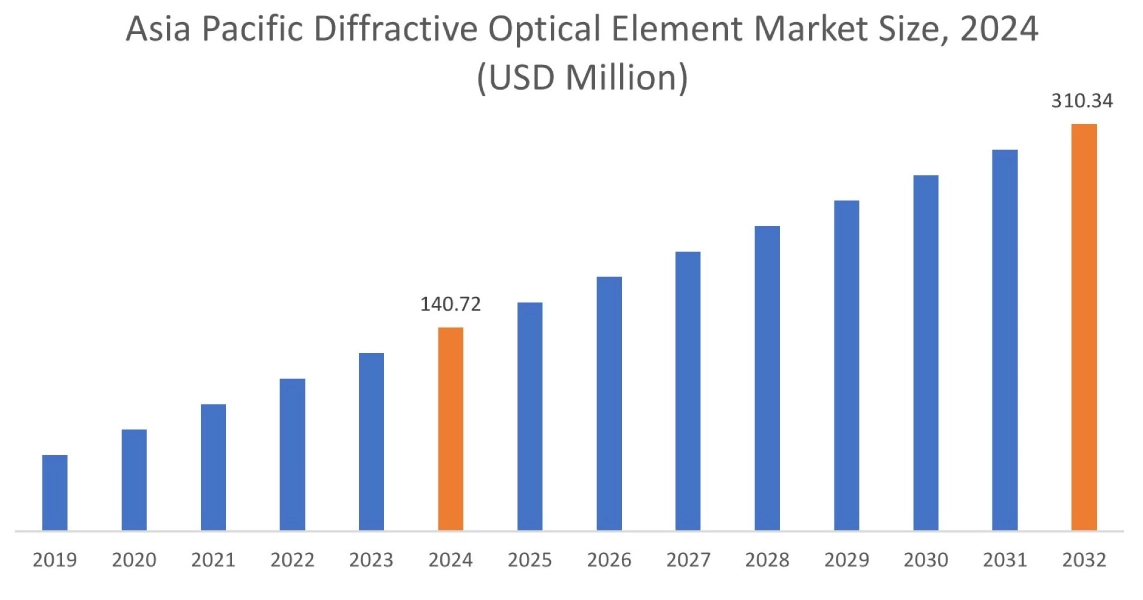
Asia Pacific region was valued at USD 140.72 Million in 2024. Moreover, it is projected to grow by USD 152.58 Million in 2025 and reach over USD 310.34 Million by 2032. Out of this, China accounted for the maximum revenue share of 32.50%. The market in the region is growing due to a strong focus on miniaturization, increasing demand for high-precision optics, and strategic investments in research and development. The region's major players in semiconductor manufacturing and laser technology contribute to the market development.
- For instance, in 2023, the Observatory of Economic Complexity states that India exported USD 2.07 billion worth of semiconductor devices. Moreover, India also imported USD 6.73 billion of semiconductor devices, becoming the 5th largest importer of semiconductor devices.
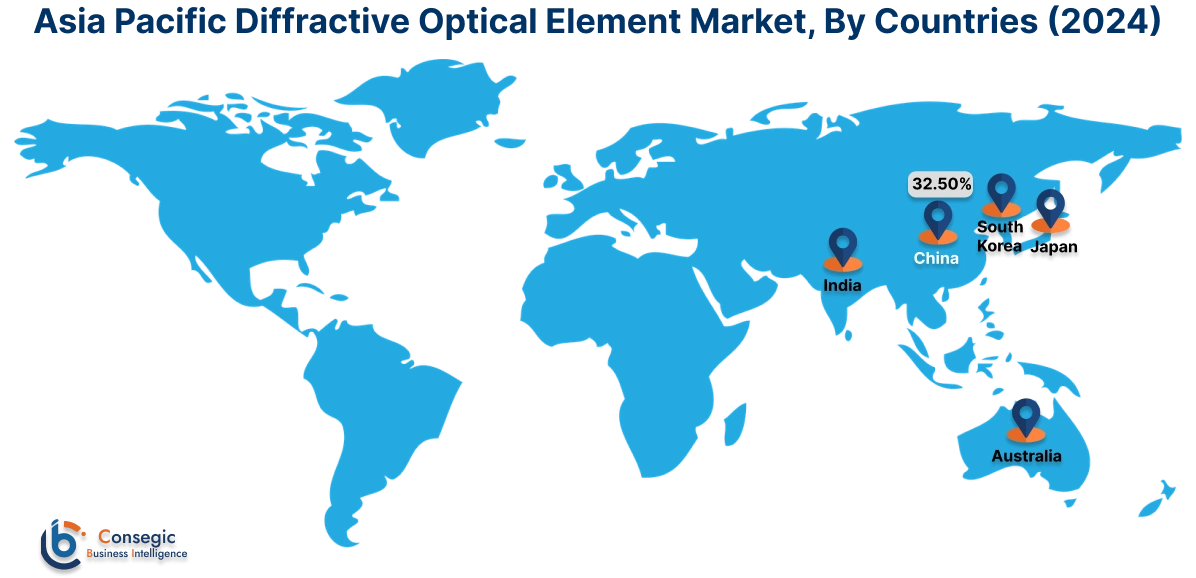
North America is estimated to reach over USD 493.50 Million by 2032 from a value of USD 233.59 Million in 2024 and is projected to grow by USD 252.37 Million in 2025. The diffractive optical element market analysis shows that the market growth in the region is driven due to factors including advancements in materials and fabrication techniques, rising investments in research and development, and the expansion of industries adopting DOE-based technologies.
The diffractive optical element market analysis depicts that in Europe, the market is driven by the increasing adoption of DOEs in various sectors like aerospace, defense, healthcare, and industrial applications. Moreover, the adoption of DOEs includes the growth of AR/VR, advanced imaging, laser material processing, and biomedical devices. In Latin America, Middle East and Africa, the market growth is driven by increasing demand for advanced technologies, growing applications in various industrial sectors, and the need for miniaturization and high precision in optical systems. Thus, the aforementioned factors are driving the diffractive optical element market expansion in the region.
Top Key Players and Market Share Insights:
The diffractive optical element industry is highly competitive with major players providing solutions to the national and international markets. Key players are adopting several strategies in research and development (R&D), product innovation, and end-user launches to hold a strong position in the global diffractive optical element market. Key players in the diffractive optical element industry include -
- Jenoptik AG (Germany)
- SILIOS Technologies (France)
- Nalux Co., Ltd. (Japan)
- HOLOEYE Photonics AG (Germany)
- Nissei Technology Corp (Japan)
- SUSS MicroOptics (Switzerland)
- LightTrans International GmbH (Germany)
- Zeiss Group (Germany)
- AGC Inc. (Japan)
- Coherent Corp. (USA)
Diffractive Optical Element Market Report Insights :
| Report Attributes | Report Details |
| Study Timeline | 2019-2032 |
| Market Size in 2032 | USD 1,166.67 Million |
| CAGR (2025-2032) | 8.8% |
| By Type |
|
| By Application |
|
| By End Use |
|
| By Region |
|
| Key Players |
|
| North America | U.S. Canada Mexico |
| Europe | U.K. Germany France Spain Italy Russia Benelux Rest of Europe |
| APAC | China South Korea Japan India Australia ASEAN Rest of Asia-Pacific |
| Middle East and Africa | GCC Turkey South Africa Rest of MEA |
| LATAM | Brazil Argentina Chile Rest of LATAM |
| Report Coverage |
|
Key Questions Answered in the Report
How big is the diffractive optical element market? +
Diffractive Optical Element Market size is estimated to reach over USD 1,166.67 Million by 2032 from a value of USD 549.85 Million in 2024 and is projected to grow by USD 594.27 Million in 2025, growing at a CAGR of 8.8% from 2025 to 2032.
What are the major segments covered in the diffractive optical element market report? +
The segments covered in the report are type, application, end use, and region.
Which region holds the largest revenue share in 2024 in the diffractive optical element market? +
North America holds the largest revenue share in the diffractive optical element market in 2024.
Who are the major key players in the diffractive optical element market? +
The major key players in the market are Jenoptik AG (Germany), SILIOS Technologies (France), SUSS MicroOptics (Switzerland), LightTrans International GmbH (Germany), Zeiss Group (Germany), AGC Inc. (Japan), Coherent Corp. (USA), Nalux Co., Ltd. (Japan), HOLOEYE Photonics AG (Germany), Nissei Technology Corp (Japan), and others.
